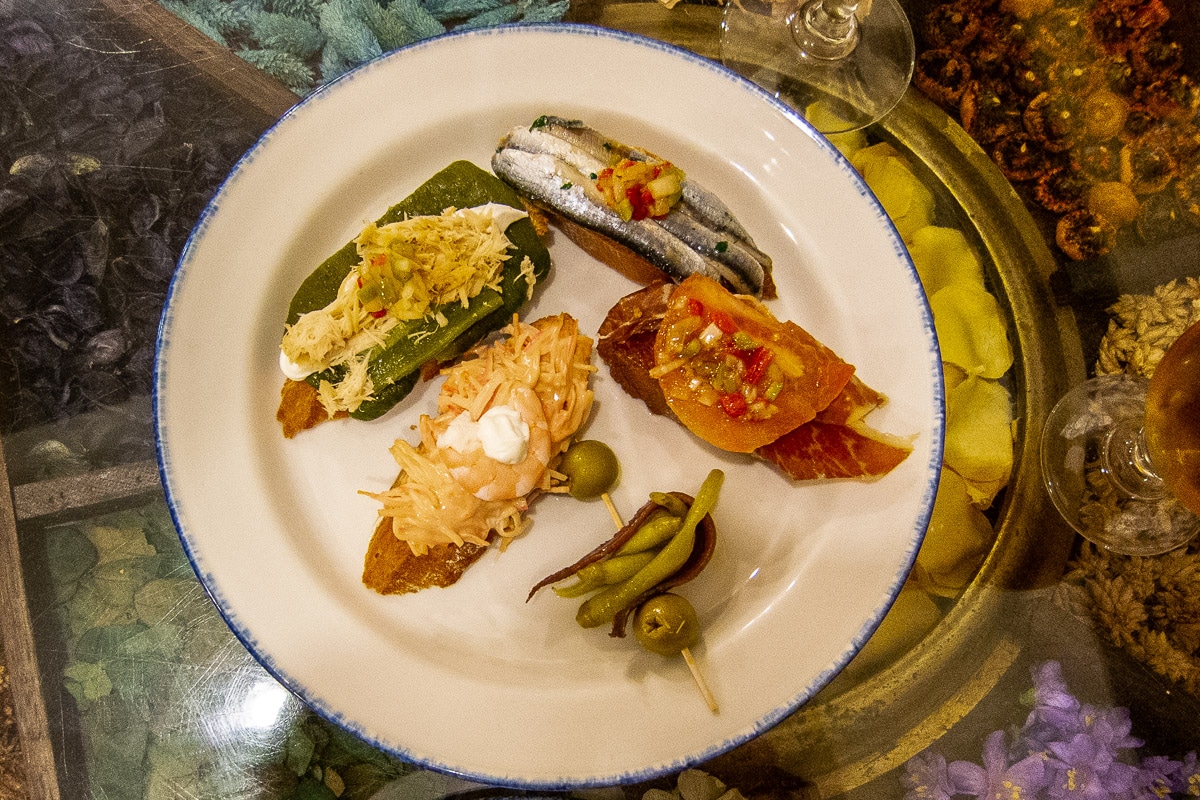
It was winter when we visited San Sebastián (or, as the Basques call it, Donostia,) so we hadn't come for the beaches, like most Spaniards and French do. (San Sebastián is famous for its surf, too.)
We came for the food.
All of the Basque Country of Spain is renowned for its food. Four of the top 50 restaurants of 2021 in the world are in the Basque Country.
We’ve tried Asador Etxebarri, ranked number 3, so far, skipped the other three until our next trip, both to give our wallet and digestive systems a respite. Until then though, and as long as we were in the pintxo capital of the world, we decided we were going to subsist on pintxos.
Pintxos are the Basque equivalent of the tapas that used to define casual Spanish cuisine. When we first came to Spain 47 years ago, every glass of wine or beer that was ordered in a bar came with a tapa. That, back in the old days, was usually a small piece of tortilla de patatas (potato omelet), a small dish of peanuts or olives, or maybe two boquerones (marinated sardines.) In a lot of bars in southern Spain, this is still how it’s done.
But in the north, and now in the big cities like Madrid and Barcelona, there’s no more free lunch. What you usually see now is plate after plate of pintxos lining the bar.
Table of Contents
What is a pintxo, or tapa?
Perhaps now is a good time to go into terminology a little bit. The word tapa literally means cap or cover. The use of the word to mean a little bite to eat came from the quaint practice of putting a little slice of bread on top of your wine glass to keep the flies out. A pintxo (which is the Basque spelling of the Spanish word pincho, a skewer) is named after the toothpick that often holds the concoction together. And a pintxo is a much more intricate undertaking than a mere tapa.
The most common form of the pintxo art is a slice of bread, either toasted or not, upon which has been piled a particular combination of, meat, cheese, vegetable, fish, or…well you name it. In pintxo-rich cities such as Bilbao, San Sebastián, or Logroño, bars up and down the street try to outdo each other in the elaboration of their offerings.
When you’re in one of those cities, you’ll often find older neighborhoods lined with bars. Customers spill out onto tables that line the narrow streets, and the sound of hundreds of Spaniards tossing back wine and beer and sharing the delicious finger food resounds off the close set walls. It’s my favorite enduring vision of Spain.
To give you an idea of the sort of pintxos you might encounter in a place like San Sebastián, I’ll just list what we had over a two-night San Sebastián food tour – which is perhaps a more genteel way of saying bar crawl.
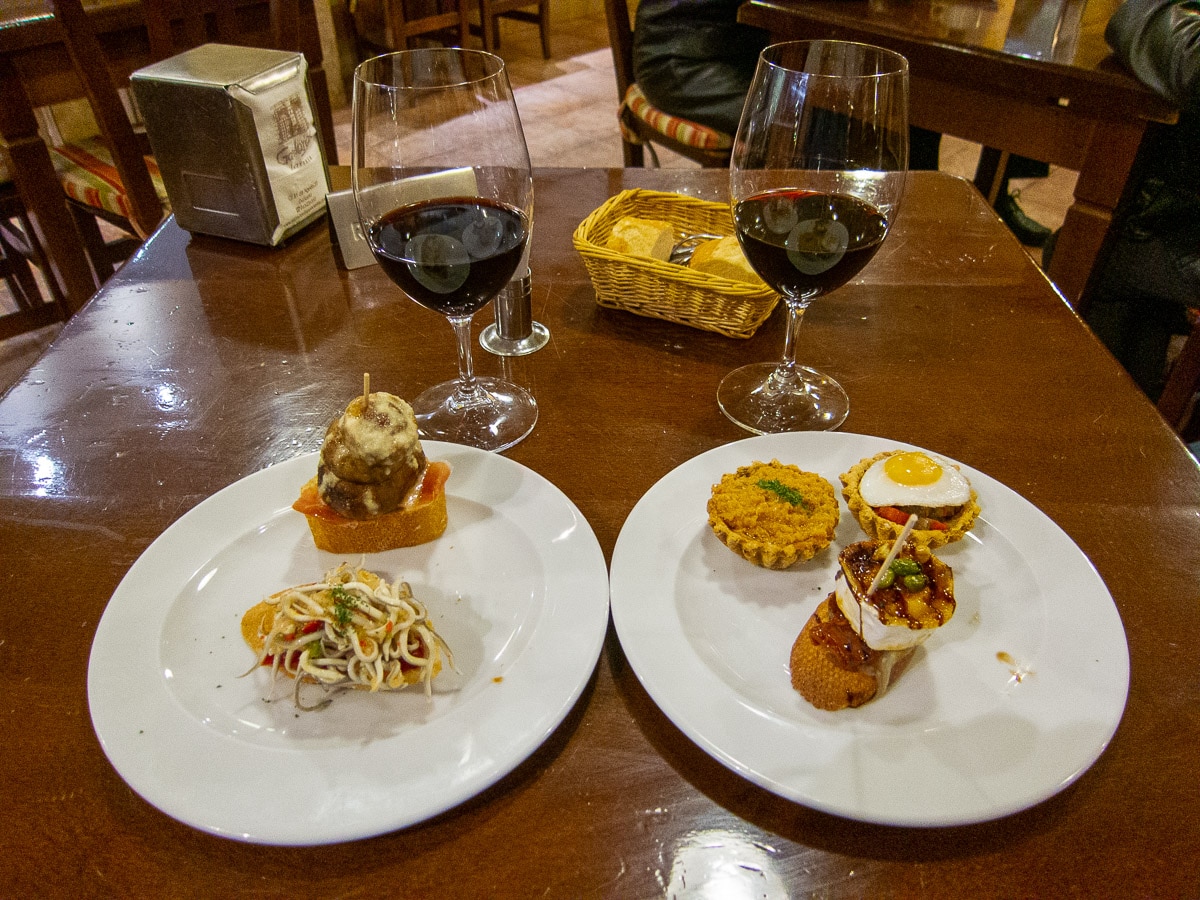
A pintxos tour of San Sebastián
The essence of dining like a native in Spain is to make several stops a night in different bars. The first night we went to three, which is maybe a bit below average. (One night in Bilbao, our son, who was living in Madrid at the time, came up to meet us there, and we went to seven bars between the train station where we met him and the hotel where we were staying. But who's counting?)
Here are the details from the first night’s excursion through the Parte Vieja (Old Town) of San Sebastián.
First stop was Taberna Juantxo at Embeltran Kalea, 6. This is a real locals joint, as the clientele indicated. There we tried four pintxos: shrimp breaded and fried with a bechamel sauce, a simple potato omelet, a shrimp with a puffy breading and deep fried, and a chili relleno (a pepper filled with cheese and deep fried.) They were all tasty bits of deep fried goodness, but not exactly what we were hoping for. (We didn’t see them on the bar. They were just on a menu posted behind.)
The second stop, though, was exactly what we were hoping for, a long bar lined with elaborate pintxos. This was Bar La Cepa, at Calle 31 de Agosto, 7, and the method of serving was simple. The bartender handed you a plate, and you went down the line loading said plate with whatever appealed to you. We chose five. They were (clockwise from the top of the photo above) 1) marinated sardines with a minced red pepper and garlic garnish, 2) jamón jabugo (jamon serrano’s tastier cousin) with tomato and capers, 3) a skewer of olives, hot peppers and an anchovy, 4) lettuce and cheese slaw in a french dressing with a shrimp and aioli topping, and 5) a grilled green pepper with tuna and caper. I expect saying they were all great is sort of redundant at this point. To wash it down, I had two small beers and Kris had two glasses of Rioja. Kris, being the snob she is, ordered the good wine.
Our third stop was Jatetxea (Restaurant) Gandarias at Calle 31 de Agosto, 23, just down the street from La Cepa. Same deal there. The bartender hands you a plate, takes your drink order and you make your way down the bar. There, we chose the following (after a few questions about what exactly we were picking) 1) a stack of grilled mushroom caps which had been drizzled with a sauce of lemon and garlic and stuck on a thin slice of ham, 2) Smoked baby eels on a roasted red pepper, 3) a pastry shell with minced crab, 4) toast with sun dried tomato, Camembert and goat cheese, topped with pine nuts and walnuts, and 5) a quail’s egg atop a pastry shell filled with caramelized onion. One glass each of the good Rioja later, and we were ready to head home. This feast set us back less than €20.
Thus, we were sated. Or so I thought. We did stop for an ice cream cone on the way back to the hotel. Kris had hazelnut and I had coffee.
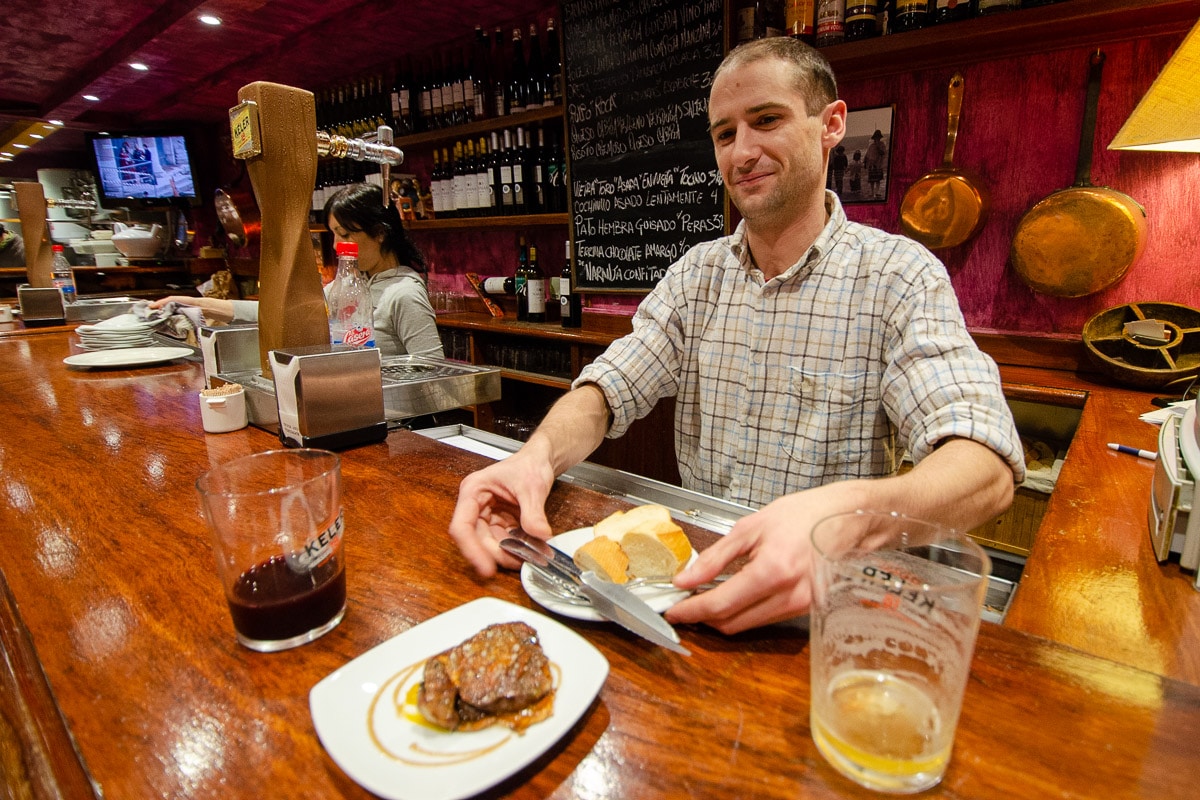
There's more to San Sebastián than pintxos
Instead of pintxos, we actually had a meal for lunch on our second day of prowling the Parte Vieja. The restaurant was called Ubarrechena (sorry, the website seems to only be in Spanish, but you can look at the pictures) and, according to the big blackboard behind our table, the specialty of the house that day was Caldoso de Arroz con Mariscos, which means seafood in a rice broth. In other words, sort of a liquid paella.
The caldoso was served in a just-off-the-boil cauldron set in the middle of our table and we were provided with spoons, knives and forks to get all the “goodie,” as my father used to say, out of the cauldron and into our bowls and then into our mouths.
The broth itself was delicious and was seasoned much like a paella – saffron and smoky paprika being the main components of the flavor. Swimming in the stew were large head-on prawns and small shrimp that had been peeled. Also, mussels, squid rings and sweet red peppers. The best way to eat those prawns is to start at the head by ripping it off the body and slurping out the shrimpy brainy broth. That’s the most intense flavor blast you’re going to get out of any seafood, in my opinion. Now I like the tails of the shrimp just fine, but I still will never be able to understand why it’s hard to buy shrimp with the heads still on in the United States…other than we seem to be a nation of queasy food wimps.
So, we sucked and slurped until everything except an inch or so of ricey broth was left in the tub. The caldoso, plus a very nice salad of lettuce, onion, tomato and tuna, a bottle of white wine from Rueda, and coffee came to a lot more than we’ll usually spend for lunch, but this was an opportunity to try something new, albeit not too daring, and we seized it. We’re like that.
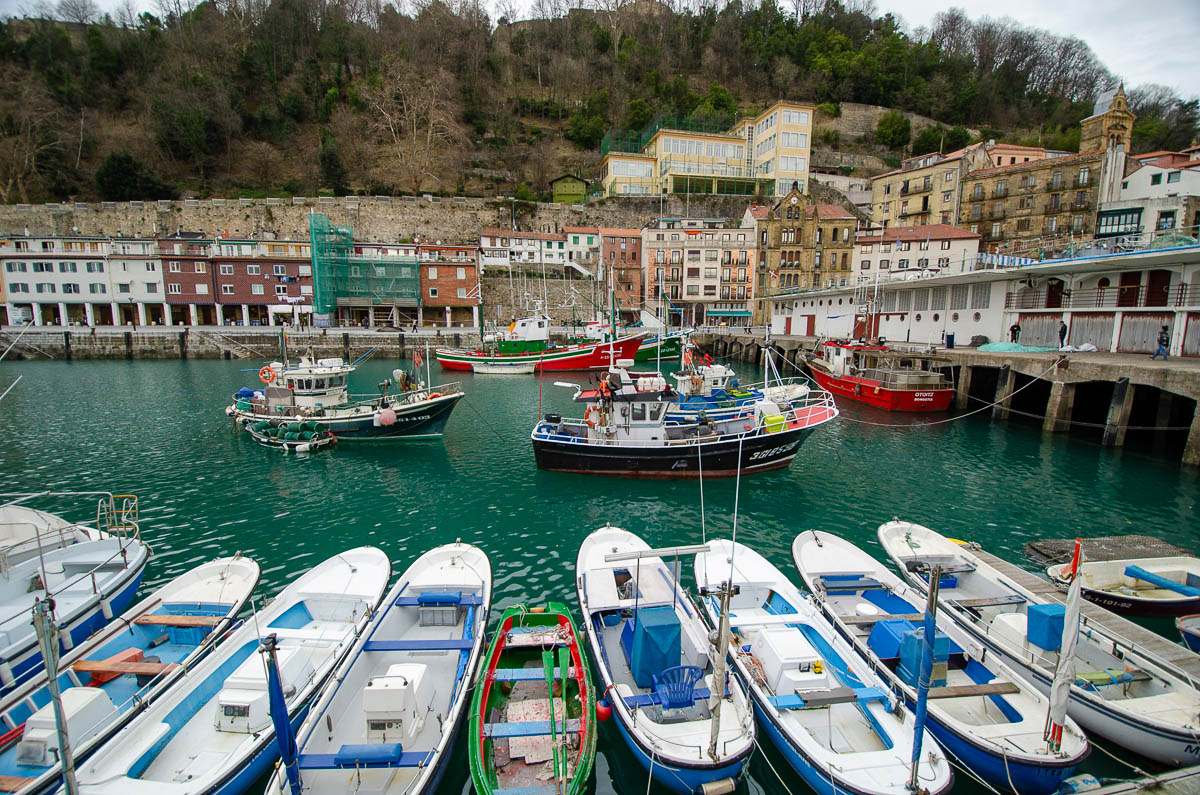
At that point, we needed to walk it off, and so decided to go around the sea wall of the San Sebastián peninsula. We started at the docks where the fishermen unload their catch of the day, and as we proceeded around, ran into the Basque Maritime Museum. This small museum essentially presents a history of the Basque Whaling Fleet from the 16th to the 20th Centuries. (They’re not whaling any more, of course.) It was a small building with two floors mostly of pictures and a few artifacts like harpoons and pieces of scrimshaw. The small admission charge included the loan of a guidebook in Spanish, which is helpful if you don’t have a clue about the Basque language–as anyone who isn’t Basque doesn’t.
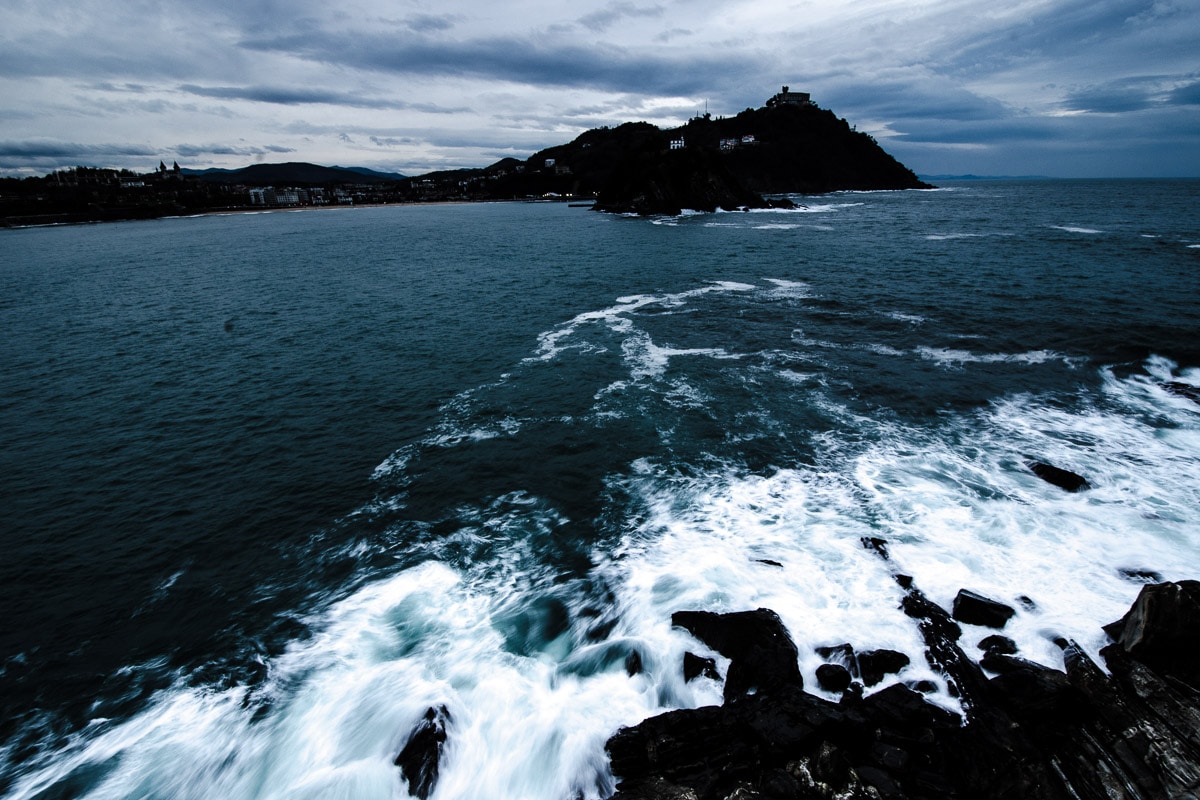
Afterwards, we continued around the wall and were enthralled with the views at dusk of the dark green sea crashing against the rocky shore. We were on a road built up over the rocks. Enough, you’d think, to protect you from the water. Not strictly true. I had stopped to take some pictures of an island in the harbor but Kris had gone ahead a bit and was standing at the railing just looking at the sea when a rogue wave hit the rocks hard enough that it actually came over the seven meter wall and completely drenched her. The Spaniards who were taking their evening walk and I all got a pretty good laugh out of that.
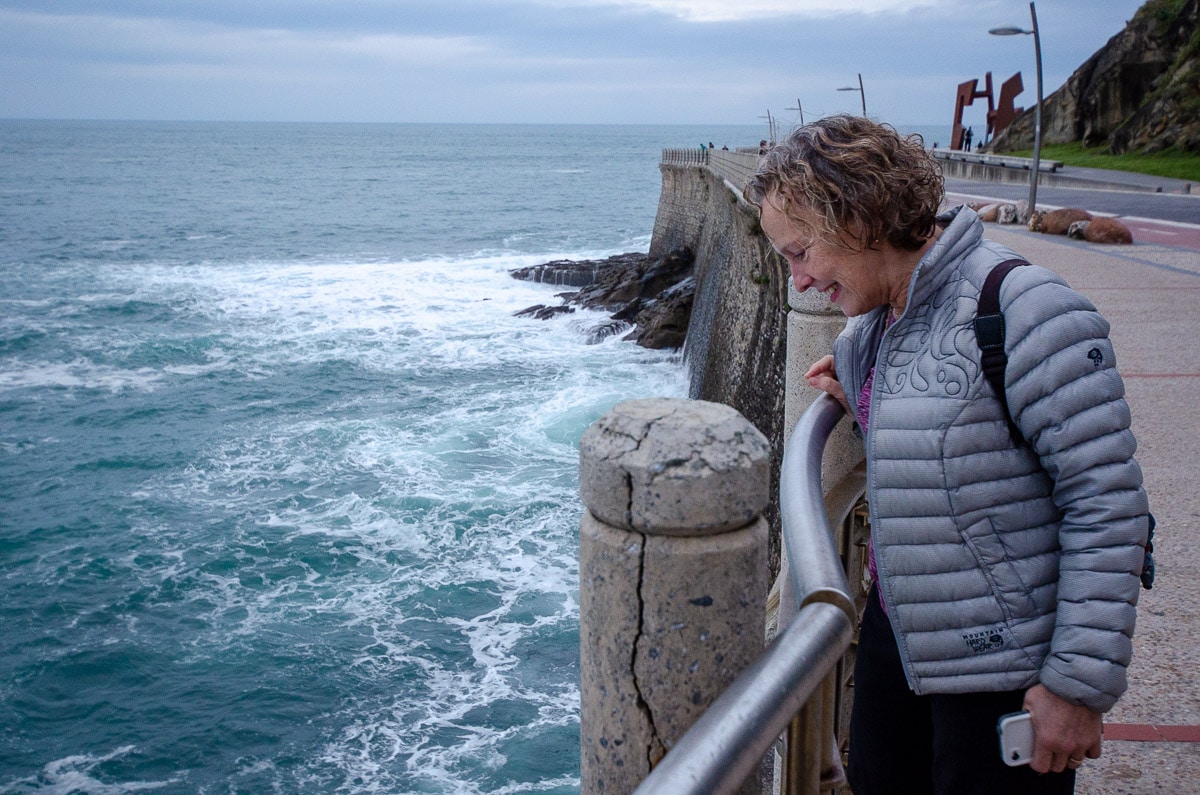
As the squishy Kris and I continued around the peninsula back into the old part of town, we ran into another exhibition.
This was a small exhibit of photography put on by what amounts to the photography club of San Sebastián. Sociedad Fotografica de Gipuzkoa it’s called, and the exhibit was about 50 images that were the winning entries of their annual competition. Not all of the photos were from Spain, but many were, and, as a long-time photography fan, I can honestly say it was one of the best concentrations of extraordinary images I’ve ever seen. I encourage you to have a look at the website. The exhibit was free. And, when we stopped to chat with the attendant to tell her how impressed we were with the show, she gave us the book of the previous year’s show, and a CD of this year’s show. (With the crisis in Spain, I don’t think they could afford the printing this year.) Like I said, have a look.
Since we still weren’t quite ready for more pintxos yet, we stopped in the plaza between the big San Sebastián art museum and a church – San Telmo, I think – to watch the kids play soccer for half an hour or so. Actually, I watched the kids. Kris stared into the museum entrance and beckoned me to enter. I was more interested in the soccer at this point, so we didn’t go in.
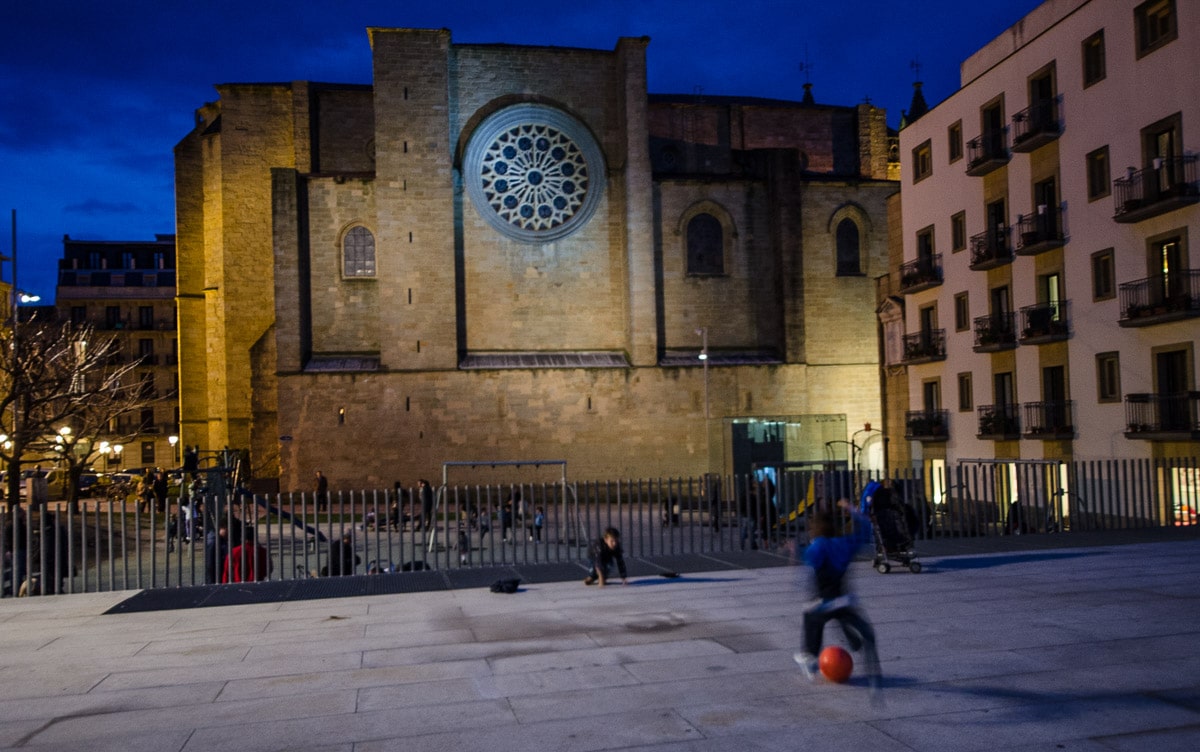
Since we’d at least worked up a thirst, if not a hunger by now, we stopped back into Bar La Cepa where we’d been the night before, but only had a bowl of anchovy-stuffed olives to go with our wine. But, with appetites thus whetted we moved up a side street to the bar La Cuchara de San Telmo where we ran, again, into pintxo paradise.
La Cuchara’s specialty is small portions of cooked meats and fish. On the menu were female duck breast (the female is more tender than the male, we were told,) veal cheeks, the ears of jabugo pigs, and, the national fish of the Basque Country, cod. We had some duck, which was stewed with pears and was amazing and then decided to venture a little out of the comfort zone and try the pig’s ear. This was not necessarily a good idea as it turns out a pig’s ear is nothing but gelatinous fat encased in crispy skin. Oh well, if you wash it down with enough beer…
We moved onto a dessert of bitter chocolate terrine with a tart sauce of reduced orange. That more than made up for the pig’s ear.
All the time we were standing at the bar, we were engaged in a far wandering conversation with Alex, the bar man. We covered love, quitting smoking, the deserts of Peru and Chile, and the difficult Basque and English languages.
I now know two words of Basque: Eskerrik asko. Thank you very much.
A food tour of San Sebastián
If you are going to visit San Sebastián to taste the food, you could do a lot worse that taking the San Sebastian Ultimate Pintxos & Wine Tour from Devour Spain Tours. Devour is owned by a personal friend of ours, and take our word for it, Lauren is the authority on Spanish food. How to find it, how to cook it, and most of all, how to eat it. Check it out.
Where to stay in San Sebastián
When it comes to deciding where to stay in San Sebastian, know that having a good home base can greatly enhance your trip.
In the Old Town, you'll be surrounded by charming cobblestone streets winding around the city’s historic buildings, and the highest concentration of where you'll want to eat.
The most vibrant street in the Old Town is Calle 31 de Agosto, lined with hopping pintxos bars and clever shops. It can get quite noisy, so stay down one of the nearby side streets for a bit more peace and quiet.
Recommended Old Town Hotels include:
Hotel SANSEbay, which offers lovely views of La Concha, contemporary rooms, and excellent value for money.
Artea Narrika, is a modern guesthouse with a clean, minimalist feel.
For a bit more upscale experience, there's the famous Hotel de Londres y de Inglaterra, right on La Concha Beach. Old school luxury, for sure.
But for real, over the top luxury, there's the Hotel Maria Cristina. Be sure to save some money for your pintxos.
And, if you have transportation, the always amazing Spanish Parador system offers the Parador de Hondarribia. Also known as the Castle of Charles V, its construction dates to the 10th century. You will feel as if you are in an authentic medieval fortress, because you are. You'll also be 25 km outside of San Sebastián, but nothing beats the Parador experience.
Up Your Travel Skills
Looking to book your next trip? Use these resources that are tried and tested by us. First, to get our best travel tips, sign up for our email newsletter. Then, be sure to start your reading with our Resources Page where we highlight all the great travel companies and products that we trust. Travel Accessories: Check out our list of all the accessories we carry to make getting there and being there a lot easier. Credit Cards: See our detailed post on how to choose the right travel rewards credit card for you. Flights: Start finding the very best flight deals by subscribing to Thrifty Traveler. Book your Hotel: Find the best prices on hotels with Booking.com. See all of the gear and books we like in one place on our Amazon shop.Got a comment on this post? Join the conversation on Facebook, Instagram, or Threads and share your thoughts!




Comments are closed.